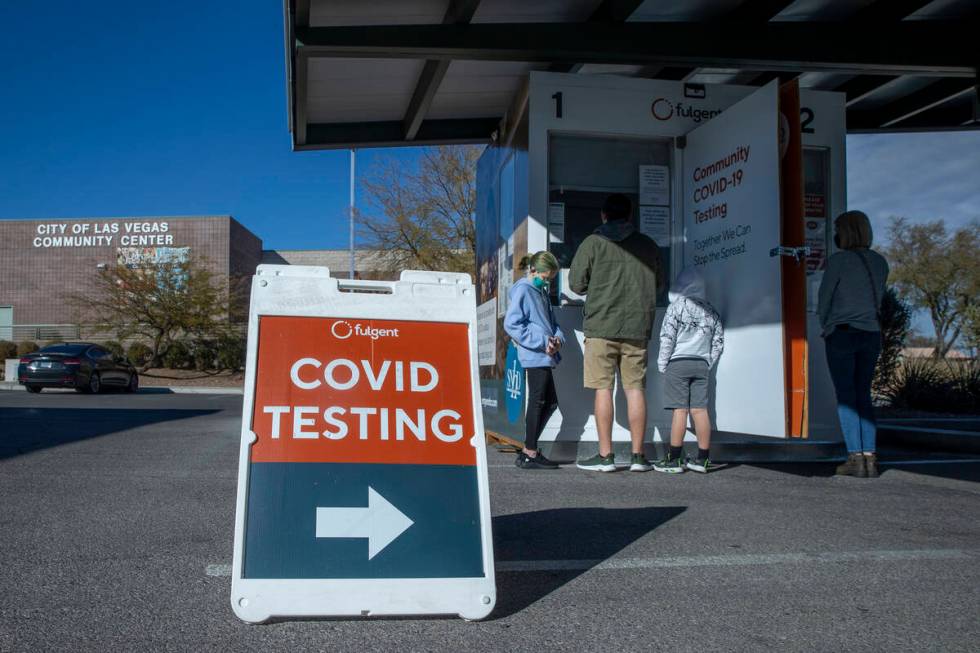For second week in a row, Clark County sees slight increase in COVID-19 cases

For the second week in a row, Clark County experienced a slight uptick in new daily COVID-19 cases, marking the first increases since January, according to weekly data released Wednesday.
However, authorities said that they don’t view the uptick as significant and that overall metrics suggest there won’t be a surge in cases anytime soon.
“From everything we’re seeing, I don’t expect a surge,” said Andrew Gorzalski, molecular supervisor in the Nevada State Public Health Laboratory in Reno. This vantage point includes positive COVID-19 test results and wastewater analysis, the latter an early-warning system for disease trends.
“There’s always fluctuations until more data comes in and more time passes, but we’re not seeing a dramatic increase in cases counts (or) in … the wastewater testing,” he said.
Despite a greater prevalence of BA.2, an easily transmissible variant, there have not been greater concentrations of coronavirus in wastewater in Southern Nevada, said Daniel Gerrity, principal research microbiologist for the Southern Nevada Water Authority.
BA.2 has triggered a significant uptick in cases in the U.K and elsewhere, and its growing prevalence in the U.S. has created concern among public health authorities.
“We have seen intermittent increases in several locations (for wastewater analysis), which would suggest small clusters of new infections, but those have generally not led to sustained increases over multiple weeks,” Gerrity said.
Researchers look at concentrations of coronavirus that have passed through the body into sewage, which allows them to detect disease trends days and even weeks before patterns can be discerned from testing individuals for COVID-19.
As of last week, BA.2 made up 70 to 90 percent of coronavirus detected in wastewater from some Southern Nevada communities, said Edwin Oh, an associate professor of neurogenetics at UNLV.
“I would say that BA.2 is already the dominant strain in wastewater and potentially in the recent infections from Southern Nevada,” Oh said.
But this dominance has not translated into greater concentrations of coronavirus in wastewater or into more cases of COVID-19, for reasons that remain unclear, he said.
Some scientists have said that the omicron wave of COVID-19 infection in the winter provided many people in the U.S. with immunity against BA.2. a variant that descended from the omicron strain. The widespread immunity decreases the likelihood of a major surge this spring, though some public health authorities believe there may be upticks in parts of the country.
Yet immunity wanes over time. There also remains the possibility that a new variant that has yet to be identified will trigger another surge. Oh doesn’t see one emerging at this point.
“Taken together, things are generally looking good right now,” he said.
Jennifer Sizemore, a representative of the Southern Nevada Health District, said it was too soon so say whether the current increases represent a significant trend.
Clark County metrics
But there were increases in most COVID-19 metrics in Clark County.
The 14-day moving average of daily new cases increased from 76 last week to 87, according to data from the state Department of Health and Human Services.
The county also reported an increase of 36 deaths over the preceding week, bringing the cumulative total to 7,825. The two-week moving average of daily deaths held at one.
The majority of the new deaths reported did not occur over the past week. Deaths are often reported well after the fact.
Also, data from the Centers for Disease Control and Prevention showed the county had a case rate of 38.29 per 100,000 people, up from 32.87 last week.
The number of people hospitalized with confirmed or suspected cases of COVID-19 in the county stood at 129, up from 114 last week.
Total cumulative case totals for Clark County were unclear, with the state Department of Health and Human Services and the health district reporting different totals for the second straight week.
The state’s total for the county stood at 496,621, while the health district total was 499,121. Those represented increases from 495,838 and 496,654, respectively.
Sizemore said in an email that local and state officials were still working to understand the discrepancy but added that numbers will “likely never completely align.”
“Currently, we have identified that that state receives records via fax and paper that are not submitted electronically to the Health District,” she said.
“Also, as you may recall, the Health District includes all cases that were tested and reported in Clark County, the state only includes cases with a Clark County address in their case counts, and the Health District is not currently including reinfections.”
Shannon Litz, a spokeswoman for the state health department, echoed Sizemore and said state and county officials are “working together to align methodologies and minimize discrepancies.”
Nevada numbers
Meanwhile, the state reported an increase of 1,026 new cases and 45 new deaths in Nevada over the preceding week, bringing totals to 659,101 cases and 10,136 deaths.
Only two of those deaths took place in the last week, according to state data.
The two-week moving average of daily new cases in the state increased from 99 last week to 112, while the two-week moving average of daily deaths dropped from two to one.
The number of people hospitalized with confirmed or suspected cases of COVID-19 stood at 163, 23 more than last week.
“Modest COVID-19 hospitalization increase appreciated in the northern region — modest decreases in hospitalizations in Clark County,” the Nevada Hospital Association said in its weekly update.
“COVID-19 hospitalizations were essentially eliminated within rural areas of Nevada. COVID-19 is not impacting hospital capacity or capabilities at this time.”
As of Wednesday, state data showed that 57.01 percent of Nevadans 5 and older were considered fully vaccinated, compared with 56.36 percent in Clark County.
Contact Jonah Dylan at jdylan@reviewjournal.com. Follow @TheJonahDylan on Twitter. Contact Mary Hynes at mhynes@reviewjournal.com or 702-383-0336. Follow @MaryHynes1 on Twitter.